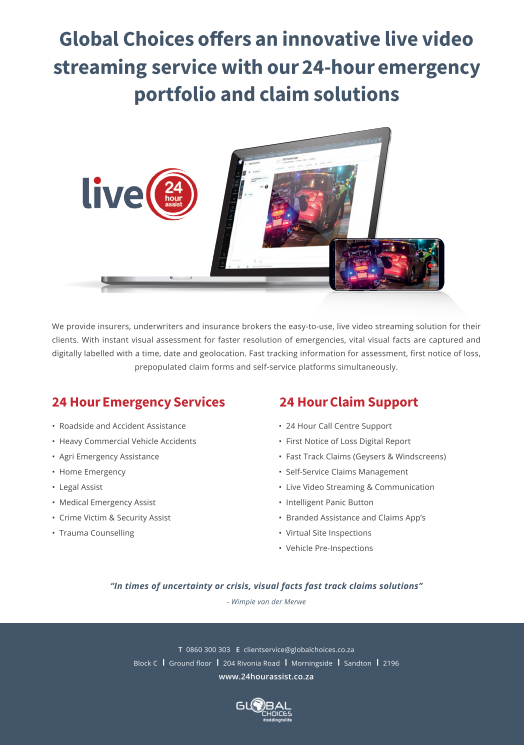Wimpie Van Der Merwe

At Global Choices, we predict it will be the value of a Total Customer Experience that will overtake price and product as the key differentiator in the insurance sector. One of the biggest challenges brokers face is how to connect and to be constantly available to communicate, engage, advise and delight their customers across multiple channels, formats and digital device types – 24hours a day.
The era of digital transformation has changed the way companies interact with their customers, creating an environment where marketing, information and technology must collaborate as a seamless service. Companies like Amazon, Apple and Google are the benchmark adopters and developers of digital platforms that deliver a satisfying customer experience. As digital, mobile and social media networks rise exponentially, customers rely on smartphones and tablets to search, investigate, assess value and buy products online – anytime, anywhere.
Today’s hyper-connected customers expect the same personalized, 21st-century experience from their insurance broker as they do from their favourite app, search engine, or online retailer. Insurance brokers must constantly re-evaluate their business models and strategies to remain relevant and competitive, and take advantage of potential wallet share. Failing to adapt to the fast pace of digital transformation is the biggest threat to broker sustainability.
360° customer-centric
360° customer-centric design is about understanding your customers’ needs, as well as how they think and behave. These insights become the guide or framework as you combine and integrate them into every aspect of your business processes across the digital landscape. The influence of demographics and information overload drives the case change within the context of the insurance value chain. Digital adoption is the new norm and insurance brokers cannot risk sitting on the sidelines.
Insurance brokers need to rethink the principles of how they do business to stay relevant in the insurance game. They need to be seen as trustworthy, digitally capable, and able to provide caring support and guidance to their customers if anything goes wrong. Or – even before things go wrong – brokers need to act as preventative risk facilitators and advisors by connecting customers to their own personalised, branded digital products and services that will make their lives easier and safer – 24 hours a day, seven days a week.
Change the operating model
However, digital transformation is not just a matter of integrating new tech. The way your business is set up must be transformed, too. Every touchpoint needs to become 360° customer-centric. The days of insurance being organised around products are gone. Things have evolved more to focus on experience and service. Your focus needs to be on customer segments and life stages, with multi-skilled staff who can resolve as much as possible in one contact. With most of the repetitive admin work now automated, insurance brokers need to look at whether this presents an opportunity to bring work back in house and shift their customer contact focus from ‘product’ to ‘event’ as they step in to assist and manage a risk event.
How to start
In the early days we expected the internet to kill the middleman. These days we know that if insurance brokers harness the internet and digital platforms more efficiently, it can actually make them stronger. Start by having your own branded 24-hour call centre and number available for customers. This will become the extension of your service. Too many insurance brokers still say it is the insurance company’s problem or service. That is plain wrong! The customer bought insurance from you, the broker, and they expect you to take care of the service, especially in any risk emergency that translates into a claim.
Rethink your website and service strategy to provide more interactive web functionality and self-service, and make sure your website is mobile friendly. Customers expect more efficiency and transparency in the claims process, and they expect to have several channels available for submitting and settling claims. Create your own branded app or collaborate with a digital specialist that combines emergency care with claims assistance, advice, communication, scalability, sales, policy schedules and risk prevention efficiencies. Customer insights start with customer intelligence. Customers expect brokers to know who they are and what they’re interested in. The 360° customer view is the idea – sometimes considered unattainable or siloed – that aggregating data from various insurance touchpoints can create a single customer view and personal experience.
Our growing reliance on digital technologies is not only reshaping customer expectations but has been dramatically redefining the insurance industry since its origins in 1668 in Lloyd’s coffee shop, with risk mitigation via indemnity and with minimum interactions with customers, to being more interactive and seeing risk management as a valuable service to deliver indemnity as a part of risk facilitation.
The insurance broker of the future:
Brokers won’t disappear! Their skills and experience will still be critical to many customers seeking independent advice. To remain truly relevant in the new, digitised insurance ecosystem will require traditional insurance brokers to become insurance brokers of the future: digitally sophisticated and focusing more on strategic advice in order to deliver the transparency and control that today’s connected customer needs.
Be an early mover and the rewards can be substantial. Insurance brokers need to understand the full scale and nature of the change they face. New, dynamic entrants – insurer players among them – are disintermediating insurance brokers by using the SME market as a launch pad. The pressure on the insurance broker’s top line is already intense. Insurance brokers need to change and reap significant rewards by setting new product and service standards.
Today’s insurance customers seek greater risk prevention, ease of doing business, as well as customised and value-adding services. As digital disruption intensifies, insurance brokers will need to protect and defend their core business while also launching new, value-creating strategies. Platform business models can help them to do both.


